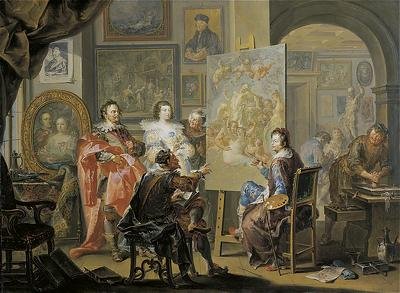
My featured artist for My Daily Arty Display is the Austrian painter and draughtsman, Johann Georg Platzer, who was born in 1704 in St Paul in Eppan, a small village in the South Tyrol, Austria. He came from a family of painters and was tutored, when young, by his stepfather Josef Anton Kessler and then later by his uncle Christoph Platzer, who was the court painter in Passau. In 1724 at the age of twenty, he painted an altarpiece for the church of St Helena in Deutschnofen. Probably after 1726 he went to Vienna, where he enrolled at the Akademie der Bildenden Künste and became a friend of Franz Christoph Janneck, one of the leading lights of Austrian Rococo art. Perhaps because of a stroke that impeded his work, he returned to St Michael in Eppan by 1755. In 1761 Platzer died aged 57.
Platzer produced a great number of small paintings, mostly on copper. He was the most important master of the informal group portraits, known as conversation pieces in 18th-century Austria. His cultivated embourgeoisé public was fascinated by the skilful manner, lively colours and countless details of his compositions. According to the principles of modesty and good manners, he chose his models and style to suit the subject-matter: for histories and allegories he took his models from antiquity, the Renaissance and Italian and Flemish Baroque art, as in Samson’s Revenge which hangs in the Belvedere in Vienna. In his genre scenes and more so his conversation pieces, one can detect the inspiration of the French Rococo and the Netherlandish cabinet painters, while in his scenes of today’s featured painting, The Artist’s Studio, his academic knowledge is revealed.
My Daily Art Display is, as I have just said, The Artist’s Studio by Johann Georg Platzer . This oil on copper painting shows the interior of an artist’s studio. If we look at the painting we see the various stages in the production of a painting. In an arched recess in the right background, behind the figure of the man grinding pigments, we can see a group of young students intently drawing the anatomy of an écorché, a figure drawn, painted, or sculpted showing the muscles of the body without skin. Their silent work ethic provides a telling contrast with the outspoken and garrulous ways of the old art critic. Above the heads of the students Platzer has introduced one of his own history paintings: The Samnites before Curius Dentatus.
In the centre foreground we are witnesses to the animated conversation which is taking place between the old critic seated on a stool and the artist himself. The artist, who has been at work on a freely-painted picture of a Bacchanale in the Venetian style, has interrupted his painting to listen to his elderly visitor, who gestures towards the picture on the easel, as though providing a critique of the painting, or maybe he is just talking about art in general because in his lap we see a book which may be a theoretical tome. The inclusion of the book could well be Platzer’s condemnation of art critics by pointing out to us that the critic has probably gained all his artistic knowledge from books and has little or no practical experience of painting.
To the left of the artist and the critic stand an elegant and aristocratic couple wearing seventeenth-century costume, probably patrons of the artist. While her husband strikes a swaggering pose reminiscent of a full-length portrait by Van Dyck, his wife, also wearing a Van Dyck dress, looks out of the picture, as though coolly appraising us, the viewers, with an air of scornful disdain. The addition of paintings on the walls reminds one of the 17th century Flemish paintings which depicted collector’s picture galleries which of course alluded to their wealth. In the middle of the back wall hangs a genre painting in the style of Teniers, an artist who was very popular with 18th-century collectors. If we look above the top left corner of the easel we can see a copy of Holbein’s Portrait of Erasmus. To the left, by the window, there is an engraving after Van Dyck’s Portrait of Gustavus Adolphus of Sweden pinned to the wall. His costume reflects that of the elegantly dressed visitors below. Just below the engraving, in an elaborate carved and gilded frame we can see a picture, which has a self-portrait of Platzer looking over the shoulder of a beautiful young woman as she offers a scrap of food to a parrot. This double representation, male with female, is in the tradition of marital portraits, but strangely Platzer himself never married, so we can only wonder at his reasoning for the inclusion of this painting. Could she be his favourite model or even his mistress?

Good points